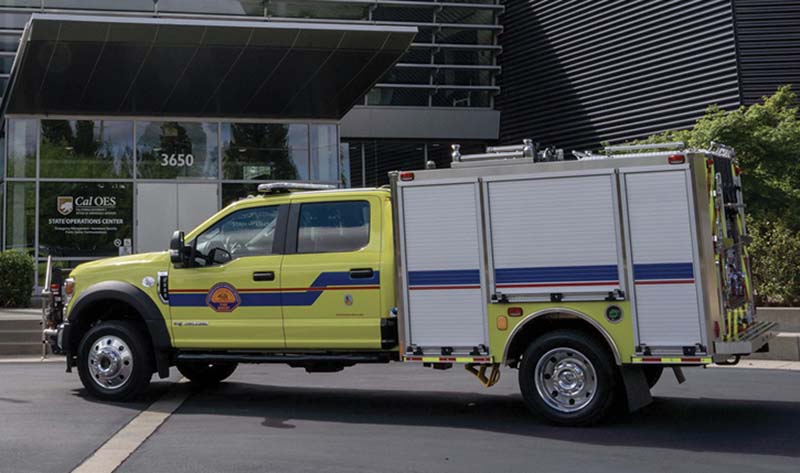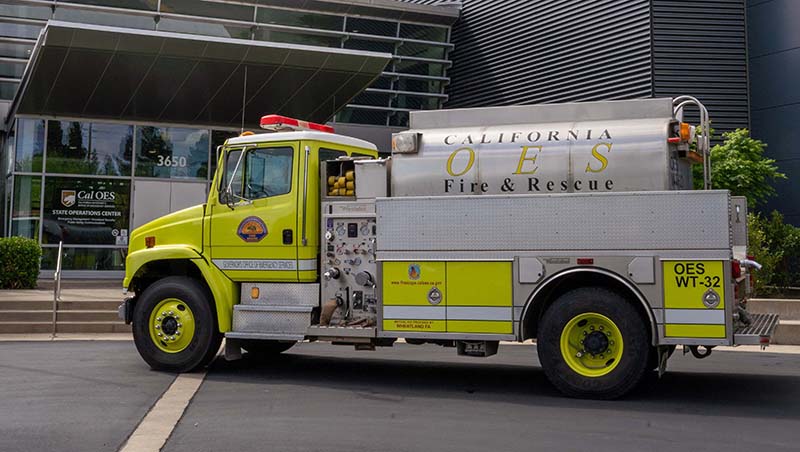The California Department of Forestry and Fire Protection (CAL FIRE) is a fire department of the California Natural Resources Agency. The California Governor’s Office of Emergency Services (CAL OES) manages a statewide fire and rescue program, providing apparatus on loan to local fire departments.
Both organizations account for a wide variety and number of fire apparatus used to battle wildfires around the state, from Type 1 wildland urban interface engines to tactical water tenders.
Brian Marshall, chief of CAL OES Fire and Rescue Division, says that CAL OES coordinates the state response to disasters that occur in six mutual-aid regions across the state, while CAL FIRE’s mission is fire protection on state forestry land totaling 31 million acres. Marshall notes that under the California fire and rescue mutual-aid system, CAL OES purchases apparatus and then assigns the rigs to local government fire departments.

1 CAL OES apparatus includes Type 1, 3, and 6 engines; tactical water tenders; incident command vehicles; hazardous materials response units; and urban search and rescue vehicles. (Photos 1-5 courtesy of California Governor’s Office of Emergency Services.)

2 The CAL OES Type 1 engine manufactured by HME Ahrens-Fox is on a 1871 SFO chassis and cab, carrying a 1,500-gpm Darley LDM 1500 single-stage midship pump, an 800-gallon water tank, a 20-gallon foam tank, a Darley 1-½ AGE auxiliary pump, and a FoamPro 1600 foam proportioning system.

3 The Type 3 engine made by BME Fire Trucks LLC for CAL OES is on an International chassis and carries a 500-gpm Darley JMP 500 two-stage pump, a 500-gallon water tank, a 20-gallon foam cell, a Darley 1-½ AGE auxiliary pump, and a FoamPro 1600 foam system.

4 HME Ahrens-Fox makes Type 6 engines for CAL OES with a 500-gpm Darley JMP 500 two-stage pump, 300-gallon water tank, 20-gallon foam cell, Darley 1-½ AGE auxiliary pump, and FoamPro 1600 foam system.

5 CAL OES’s tactical water tender is made by Westates on a Freightliner FL-80 chassis and cab with a 500-gpm Darley JMP 500 two-stage pump and a 2,000-gallon water tank.
“When we need the engines to fight wildland fires, the local departments put their firefighters on the engine and respond to the incident,” Marshall says. “When not in service with us at wildland fires, the fire departments get a free fire engine to use for training, to replace other apparatus out of service, or for major incidents.”
He points out that while CAL OES doesn’t have firefighters on its engines, it does have chief officers to manage wildland fire incidents. “We track the cost to the local government to staff the engine and respond to an incident, and our administrative staff generates an invoice based on the documents from the incident and gets the local fire department reimbursed,” Marshall says.
The fleet that CAL OES currently operates includes 114 Type 1 engines, 67 Type 3 wildland engines designated as the Model 34, 79 Type 6 wildland engines, and 12 water tenders (tankers)—two for each mutual-aid region. CAL OES also has six command trucks, which it calls incident support vehicles, one in each region; 12 Type 2 hazardous materials response units (two per region); six regional USAR (urban search and rescue) trailers; and 13 swift water rescue teams, each consisting of a truck, trailer, and boat.
Marshall says that in the past, CAL OES Type 1 engines have been manufactured by Westates and HME but that the new Type 1 spec has HME Ahrens-Fox producing the pumper on the 1871 SFO chassis and cab, powered by a 365-hp Cummins L9 diesel engine and an Allison 3000 EVS six-speed automatic transmission. The Type 1 has a 1,500-gpm Darley® LDM 1500 single-stage midship pump, an 800-gallon water tank, a 20-gallon foam tank, a Darley 1-½ AGE auxiliary pump for pump-and-roll capability, and a FoamPro 1600 foam proportioning system. CAL OES Type 1 engines also carry a HURST Jaws of Life® eDraulic® cutter, spreader, and ram and Type 3 USAR equipment managed by Firefighting Resources of California Organized for Potential Emergencies (FIRESCOPE).

6 BME Fire Trucks builds Type 3 engines for CAL FIRE, designated the Model 34, with a 500-gpm Darley JMP 500 two-stage midship pump, a 500-gallon water tank, a 20-gallon foam cell, a Darley 1-½ AGE auxiliary pump, and a FoamPro 1600 foam system. (Photo 6 courtesy of BME Fire Trucks LLC.)
CAL OES Type 3 engines have been manufactured by Rosenbauer, HME Ahrens-Fox, and Boise Mobile Equipment (now BME Fire Trucks LLC), which has the current contract. The Type 3 spec calls for an International chassis and cab, a 360-hp Cummins L9 diesel engine, an Allison 3000 EVS five-speed automatic transmission, a 500-gpm Darley JMP 500 two-stage pump, a 500-gallon water tank, a 20-gallon foam cell, a FoamPro 1600 foam proportioning system, and a Darley 1-½ AGE auxiliary pump.
The CAL OES Type 6 engines manufactured by HME Ahrens-Fox are built on Ford F-622 chassis and cabs, powered by 325-hp Ford 6.7-liter engines and six-speed automatic transmissions. The Type 6 spec calls for a 500-gpm Darley JMP 500 two-stage pump, a 300-gallon water tank, a 20-gallon foam cell, a FoamPro 1600 foam proportioning system, and a Darley 1-½ AGE auxiliary pump. The Type 6 also carries a HURST Jaws of Life eDraulic cutter, spreader, and ram.
Marshall points out that the eDraulic tools were recently added to the Type 6’s equipment load. “In the event of an earthquake, the Type 6 will be able to maneuver in areas where collapsed buildings might make it difficult for larger apparatus,” he says.
The CAL OES tactical water tender manufactured by Westates is built on a Freightliner FL-80 chassis and cab, powered by a 300-hp MBE 6.4-liter engine and an Allison MD 3560 P six-speed automatic transmission. It has a 500-gpm Darley JMP 500 two-stage pump and a 2,000-gallon water tank.
Ed Boring, fleet sales manager for HME Ahrens-Fox, says, “We are the current contract holder for CAL OES and have sold them 170 Type 1 engines and 50 Type 3 wildland engines. With the newest contract for the Type 1, which CAL OES designates the Model 18, we came up with an improved version that makes the cab more deployment friendly.” Those changes include forward seating for four firefighters, SCBA removed from the seats and carried on a tree in the cab, large console trays with drink holders, USB chargers, a tray for cell phones, under seat storage for personal items, and in-cab gear racks for personal protective equipment .
Boring says the Type 1 HME Ahrens-Fox is building for CAL OES carries a Darley LDM 1,500-gpm single-stage midship pump, an 800-gallon water tank, a 20-gallon foam tank, a Darley 1-½ AGE auxiliary pump with controls in the cab and on the pump panel, a FRC foam system, and a Trident air primer.
The Type 1 has a front bumper discharge, a large-diameter hose discharge on the right side, three rear discharges, and a large rear compartment to accommodate HURST eDraulic rescue tools. The Type 1 also has a HiViz 76-inch LED brow light and a Whelen LED emergency light package and scene lighting.
Boring adds his company was the contract holder for a number of years for CAL FIRE’s Type 3 engines, with the agency purchasing about 350 of the units.
Chad Moffat, president of BME Fire Trucks LLC, says BME has had the CAL FIRE and OES contract for Type 3 engines since 2017 and was recently awarded another three-year contract for the rigs along with two one-year extensions. “We build their Type 3 Model 34 engines and also their crew carriers,” Moffat notes. “We’ve built 27 for OES and 140 for CAL FIRE, with another 40 to be delivered under the prior contract.”
Moffat says the Model 34 has a 500-gpm Darley JMP 500 two-stage power-takeoff (PTO)-driven midship pump, a 500-gallon water tank, a 20-gallon foam cell, a FoamPro 1601 foam proportioning system, and a Darley 1-½ AGE auxiliary pump powered by a 24-hp Kubota engine for pump-and-roll capability.
Matt Stocker, BME director of sales, adds BME changed the body-to-cab height on the Model 34, with the entire body structure reaching to the top of the cab because of BME’s tubular construction, which provides greater safety for firefighters. “The Model 34 is designed to be as short as possible,” Stocker says, “with a 183-inch wheelbase, overall length of 26 feet 11 inches, and overall height of 9 feet 7 inches. The rig has two 30-foot preconnected jump lines in the front bumper, two 100-foot 1¾-inch hose crosslays above the midship pump, an off the rear hosebed, 200 feet of preconnected 1¾-inch hose, 100 feet of preconnected 1¾-inch hose, 500 feet of either 3-inch or 2½-inch hose, and a 2½-inch discharge on the rear that can be preconnected to a blitz line in the left hosebed.”
ALAN M. PETRILLO is a Tucson, Arizona-based journalist, the author of three novels and five nonfiction books, and a member of the Fire Apparatus & Emergency Equipment Editorial Advisory Board. He served 22 years with the Verdoy (NY) Fire Department, including in the position of chief.

